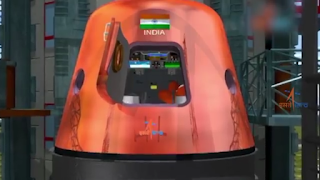Gaganyaan update 20/10/2020: ISRO's human spaceflight project launch set for August 2022
ISRO chairman Dr. K Sivan indicated that the Indian human space flight is set for August 2022, although some small shifts may take place owing to disruptions due to the ongoing covid-19 pandemic.
what is Gaganyaan mission and INTERIOR?
During his Independence Day speech on 15 August 2018, Prime Minister Narendra Modi had said when the nation is celebrating the 75th year of Independence in 2022, an Indian son or daughter will be flying into space.
who will go in Gaganyaan mission
ISRO has not yet told who will go to the Gaganyaan mission.
Because ISRO feels that this can spoil the safety of these astronauts.
Including interior
let's learn ISRO pace-expo is going on the CII channel There was a session on Gaganyaan, got to know new things Let's check new info one by one.
we got to see the final design for gaganyaan The screen image is most likely the final design for Gaganyaan the orange module on top is the crew module CM...where Astronauts will live
the box type thing below is service module SM- where fuel and other important stuff reside these 2 will be connected by an external connector It is not shown in the image.
Then there are 4 sets of fold-out solar panels apart from that there will also be a radiator We do not know the exact location...
it seems that's its the service module surface Final design seems cool
 |
| Gaganyaan interior |
It will have 5 engines
on the left, you can see HRLV
HRLV is the human-rated version of GSLV MK3 Human rating will be a challenge
will surely make a video on it
and finally
we got the orbital parameters 400 km at 51.5 degrees inclination 3 crew members for 5 to 7 days.
It was rumored that... there might be only 1 crew member on the 1st flight on the G3 mission.
we'll see as an when the news comes we got to see what the SM and CM are doing in a brief
ISRO had the same budget as NASA
ISRO mangalyaan has discovered the red planet is losing its air to space
India’s first solar mission Aditya-L1 to unravel many mysteries
ECLSS - Environment Control and Life Support System you can see oxygen tanks on top as well as bottom there is also an O2+nitrogen tank
It's not ideal to have a pure oxygen environment It can be flammable and more dangerous hence NASA learned this the bad way
You can see Carbon Dioxide scrubbers in there it will remove CO2 from the air
Toilet, water and space food can be seen we can see a 2 stage cooling system A couple of heat exchanges on top
it will dump the heat down and from there to the radiators, L-L Hx is liquid to liquid heat exchange G Hx meaning Gaseous Heat Exchange
Assuming, but most probably it is the same Hence SM and Cagayan(CM)
SM will burn up during reentry, the only capsule will come back to earth Then we got to see the shortlisted science experiments 6 of them have been shortlisted.
You can pause and read then we saw a very important slide That is Gaganyaan Immediate milestones so hopefully in a year?
You can see Chinook helicopter with the gaganyaan capsule then it will be dropped and parachutes will open it will have to then safely land
ADMIRE
ASMIRE is our reusable vehicle technical demonstrator One of its variants is being used where it's most likely an L40 booster of GSLV MK2 But we don't see landing legs here, which means it won't survive so it will be destroyed most likely during launch and o top of ADMIRE is the in-flight abort(IFA) capsule to which the Launch escape motors are attached In case the rocket starts misbehaving the top motors will fire and pull away capsule to a far off point I have an animation on that too
then the Pad abort test, ISRO already has conducted one and seems like they are going to perform a second one with the new refined design as you can see the design is very different from the current one.
then the big one... 1st unmanned flight.
we need to stop using the manned phrase ... let's say unscrewed because all Indians regardless of gender may get an opportunity to be on board The 1st unscrewed flight G1 was supposed to happen in Dec 2020 but.......
we should see this sometime next year G1/G2 will be the 1st unscrewed flights G3 onward crewed missions begin
Can't wait for that day
It will be the Nation's festival
That is the Gaganyaan interior
we did see a cutaway which is on the screen we also got to see the same in one of their animations let's speculate and discuss
Let's see the seat 1st
The green on the seats.
they are not hydraulics but you can call them attenuators they will absorb the shock of the landing or a rough landing
Gaganyaan will land on water
the seats will be custom made for the crew you might think people are crammed in but this is normal since back support is more important in a rocket launch IF I show you Russia's Soyuz
Everybody is so crammed in
But Gaganyaan seems very open and spacious which is great
The face is on the side of the hatch 'So I'm wondering how they'll enter and sit if you see on the right side
there are drawers and small cabins
where things will be stored
what is written on this animation was heavily speculated by us everyone was in speculation mode in our discord medical kit on top right
storage in middle ..right waste dump this is understandable
other's were unclear instructions in community post for members speculated a lot but did not work you can see the console on the top I find the graphics weird the graphics seem to be taken from a plane model what do you think?
this animation itself seems like a preliminary animation meaning the base of the animation is ready.. they will improve on it later at least I hope so
and seems to be fewer buttons than we thought whether there will touch screens or no was a question or an airplane full of buttons
console looks clean
spacesuit is being supplied by Russia for gaganyaan
many people were not happy with the news I liked it
what is working and validated in space should be used and move forward look at china .... used a lot of Russian stuff and is ahead of them we can't wait to develop everything on our own let's develop as much as we can, take help from others for the rest and parallelly develop our own
so yeah... let's goo
the pink color part in the diagram are parachutes and we don't know if it will have a docking port the international docking adapter
we can see in some diagrams
so this was speculation
let me know in the comments
one good thing is we have a spacious cabin important because astronauts will speed all time here early on we won't have a space station or separate module experiments will need space hence proper utilization is important so Astronauts get a lot more space for experiments and general legroom slides were amazing
wish we had more details
the session was supposed to be 1 hr but got over in half an hour but it's okay
I have some interesting images from their video, which I will post on social media and community posts.











